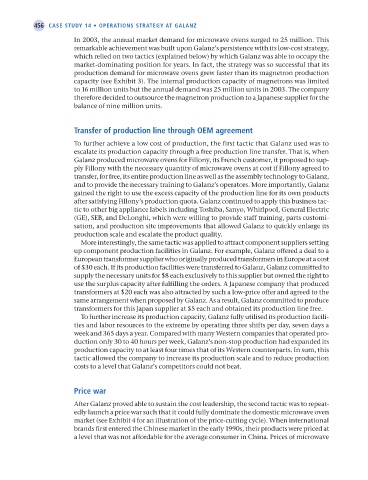Page 481 - Operations Strategy
P. 481
456 case study 14 • OperatiOns strategy at galanz
In 2003, the annual market demand for microwave ovens surged to 25 million. This
remarkable achievement was built upon Galanz’s persistence with its low-cost strategy,
which relied on two tactics (explained below) by which Galanz was able to occupy the
market-dominating position for years. In fact, the strategy was so successful that its
production demand for microwave ovens grew faster than its magnetron production
capacity (see Exhibit 3). The internal production capacity of magnetrons was limited
to 16 million units but the annual demand was 25 million units in 2003. The company
therefore decided to outsource the magnetron production to a Japanese supplier for the
balance of nine million units.
transfer of production line through OeM agreement
To further achieve a low cost of production, the first tactic that Galanz used was to
escalate its production capacity through a free production line transfer. That is, when
Galanz produced microwave ovens for Fillony, its French customer, it proposed to sup-
ply Fillony with the necessary quantity of microwave ovens at cost if Fillony agreed to
transfer, for free, its entire production line as well as the assembly technology to Galanz,
and to provide the necessary training to Galanz’s operators. More importantly, Galanz
gained the right to use the excess capacity of the production line for its own products
after satisfying Fillony’s production quota. Galanz continued to apply this business tac-
tic to other big appliance labels including Toshiba, Sanyo, Whirlpool, General Electric
(GE), SEB, and DeLonghi, which were willing to provide staff training, parts customi-
sation, and production site improvements that allowed Galanz to quickly enlarge its
production scale and escalate the product quality.
More interestingly, the same tactic was applied to attract component suppliers setting
up component production facilities in Galanz. For example, Galanz offered a deal to a
European transformer supplier who originally produced transformers in Europe at a cost
of $30 each. If its production facilities were transferred to Galanz, Galanz committed to
supply the necessary units for $8 each exclusively to this supplier but owned the right to
use the surplus capacity after fulfilling the orders. A Japanese company that produced
transformers at $20 each was also attracted by such a low-price offer and agreed to the
same arrangement when proposed by Galanz. As a result, Galanz committed to produce
transformers for this Japan supplier at $5 each and obtained its production line free.
To further increase its production capacity, Galanz fully utilised its production facili-
ties and labor resources to the extreme by operating three shifts per day, seven days a
week and 365 days a year. Compared with many Western companies that operated pro-
duction only 30 to 40 hours per week, Galanz’s non-stop production had expanded its
production capacity to at least four times that of its Western counterparts. In sum, this
tactic allowed the company to increase its production scale and to reduce production
costs to a level that Galanz’s competitors could not beat.
price war
After Galanz proved able to sustain the cost leadership, the second tactic was to repeat-
edly launch a price war such that it could fully dominate the domestic microwave oven
market (see Exhibit 4 for an illustration of the price-cutting cycle). When international
brands first entered the Chinese market in the early 1990s, their products were priced at
a level that was not affordable for the average consumer in China. Prices of microwave
Z14 Operations Strategy 62492.indd 456 02/03/2017 13:59

